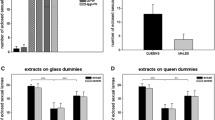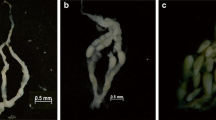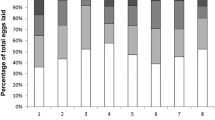Summary
The role of unmated queens in laboratory colonies of the pharaoh's antMonomorium pharaonis L. (Hymenoptera, Myrmicinae) has been investigated. In contrast to the findings by other authors we find that these females are unable to suppress the rearing of new sexuals. This is neither contingent upon the age of the unmated queens nor on the physiological condition of the colonies. In societies of different origin the situation was the same. Only after copulation are the females able to suppress the development of new sexual broods. These findings are discussed within the framework of the hypothesis established byBerndt (1975) about a pheromone controlling cyclic production of sexuals. Results on the receptivity of the unmated females in connection with a copulation effected by the parthenogenetically produced sons are presented. Furthermore, information is given on the behaviour of the unmated queen and her longevity.
Zusammenfassung
Es wurde die Rolle der unbegatteten Königinnen in Laborkolonien der PharaoameiseMonomorium pharaonis L. (Hymenoptera, Myrmicinae) untersucht. Im Gegensatz zu den Befunden anderer Autoren sind diese Weibchen nicht in der Lage, die Aufzucht von neuen Geschlechtstieren zu unterdrücken. Diese Fähigkeit hängt weder vom Alter der Virgines noch vom physiologischen Zustand der Kolonien ab. In Sozietäten unterschiedlicher Herkunft waren die Verhältnisse gleichartig. Nur nach Kopulation sind die Weibchen zur Unterdrückung der Entwicklung neuer Sexualtierbrut fähig. Diese Befunde werden im Rahmen der vonBerndt (1975) aufgestellten Hypothese über eine durch ein Pheromon gesteuerte zyklische Sexualtierproduktion diskutiert. Es werden Ergebnisse über die Rezeptivität der unbegatteten Weibchen in Verbindung mit einer durch die parthenogenetisch erzeugten Söhne erfolgenden Kopulation dargestellt. Ferner finden sich Angaben über das Verhalten unbegatteter Weibchen sowie deren Lebensdauer.
Similar content being viewed by others
References
Berndt K.P., 1974. — Die Wirkungsweise von Natriumarsenat auf Laborkolonien der PharaoameiseMonomorium pharaonis L..Biol. Zentralbl., 93, 425–448.
Berndt K.P., 1975. — The physiology of reproduction in the pharaoh's ant (Monomorium pharaonis L.) 1. Pheromone mediated cyclic production of sexuals. Paper presented on the III Symp. Med. Vet. Acaroentomol., Gdansk (Poland), 25–28th Sept. 1975.Wiadom. Parazit., 1977,23, 163–166.
Berndt K.P., 1975 a. — Eine einfache Methode zur Handhabung von Insekten. Dtsch. entomol.Z., Neue Folge, 22, 163–165.
Berndt K.P., Nitschmann J., 1977. — Neue Ergebnisse zur Biologie und Bekämpfung der Pharaoameise.Biol. Rundsch., 15, 171–179.
Berndt K.P., Kremer G. — Methoden zur Massenzucht der PharaoameiseMonomorium pharaonis (L.) (Hym.: Myrmicinae).Angew. Parasitol. (in press).
Buschinger A., Kloft W., 1973. — Zur Funktion der Königin im sozialen Nahrungshaushalt der PharaoameiseMonomorium pharaonis (L.).Forschung Land Nordrhein Westf. 2306, 34 p.
Hinton H.E., 1974. — Symp. reprod. arthropods med. vet. importance. III. Accessory functions of seminal fluid.J. Med. Entomol., 11, 19–25.
Kretzschmar K.H., 1971. — Eine Methode zur Massenzucht und Einzelbeobachtung von Kolonien der Pharaoameise (Monomorium pharaonis L.).Biol. Zentralbl., 90, 715–721.
Leahy M.G., 1973. — Oviposition of virginSchistocerca gregaria (Forskal) (Orthoptera: Acrididae) after implant of the male accesory gland complex.J. Entomol., Ser. A,48, 69–78.
Leopold R.A., 1976. — The role of male accessory glands in insect reproduction.Ann. Rev. Entomol., 21, 199–221.
Petersen M., Buschinger A., 1971. — Untersuchungen zur Koloniegründung der PharaoameiseMonomorium pharaonis (L.).Anz. Schädlingskd., 44, 121–127.
Author information
Authors and Affiliations
Rights and permissions
About this article
Cite this article
Berndt, K.P., Nitschmann, J. The physiology of reproduction in the pharaoh's ant (Monomorium pharaonis L.) 2. The unmated queens. Ins. Soc 26, 137–145 (1979). https://doi.org/10.1007/BF02223507
Received:
Accepted:
Issue Date:
DOI: https://doi.org/10.1007/BF02223507




